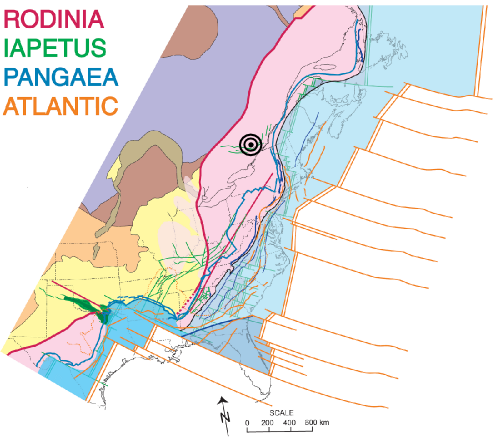![]() Yesterday, eastern Canada was shaken by a magnitude 5 earthquake. This is, at first glance, a rather surprising event, because if you were to ask me to point out the most likely place for an earthquake to occur in Canada, I would point west, to the plate boundary marked by the Cascadia subduction zone (which eventually links up to with the San Andreas Fault farther south). In contrast, Ontario and Quebec are several thousand miles from the nearest plate boundary. However, perhaps I shouldn’t be so surprised: the rupture is located smack in the middle of a zone of enhanced risk in the seismic hazard map for this area. A look in the USGS’s historical database reveals why: there have been a number of earthquakes of similar or greater size in this region in the last century: a magnitude 4.9 in 2005; a 5.9 in 1998; a 5.8 in 1944; a 6.1 in 1935; and a 6.2 in 1925. There are also reports of a what is possibly up to a magnitude 7 earthquake way back in 1663. Although earthquakes within plates might not quite follow the tectonic rules seen at plate boundaries, it seems in this case, at least for the moment, past seismic activity does provide some indication of where to expect future large(ish) earthquakes.
Yesterday, eastern Canada was shaken by a magnitude 5 earthquake. This is, at first glance, a rather surprising event, because if you were to ask me to point out the most likely place for an earthquake to occur in Canada, I would point west, to the plate boundary marked by the Cascadia subduction zone (which eventually links up to with the San Andreas Fault farther south). In contrast, Ontario and Quebec are several thousand miles from the nearest plate boundary. However, perhaps I shouldn’t be so surprised: the rupture is located smack in the middle of a zone of enhanced risk in the seismic hazard map for this area. A look in the USGS’s historical database reveals why: there have been a number of earthquakes of similar or greater size in this region in the last century: a magnitude 4.9 in 2005; a 5.9 in 1998; a 5.8 in 1944; a 6.1 in 1935; and a 6.2 in 1925. There are also reports of a what is possibly up to a magnitude 7 earthquake way back in 1663. Although earthquakes within plates might not quite follow the tectonic rules seen at plate boundaries, it seems in this case, at least for the moment, past seismic activity does provide some indication of where to expect future large(ish) earthquakes.

Seismic hazard map for Eastern Canada. Source: Global Seismic Hazard Assessment Program.
So why is this particular region so much more earthquake-prone than the rest of eastern Canada? Earthquakes within plates occur where they are not quite strong enough to support the forces driving motion, causing them to deform slightly. These weak points are generally found in older, fault-riddled bits of the crust that have gone through the plate tectonic wringer one or more times in the geologic past. Although there is currently no active plate boundary on the East Coast of North America, in the last 1000 million years or so it has been through a continental collision (the Grenville orogeny associated with the formation of the supercontinent of Rodinia), a rifting event (the formation of the Iapetus Ocean), then another continental collision (the closure of Iapetus and the formation of the supercontient Pangaea), then another rifting event (the opening of the present Atlantic). Faults related to all of these past episodes of tectonic activity can be found along the margin, as summarised in the color-coded figure below, taken from Thomas (2006) (pdf); this concentration of structures, easily reactivated by any applied tectonic stress, are the reason that this edge of the North American plate is much more seismically active than the continental interior.

Click image to enlarge. Source: >Thomas (2006).
This particular earthquake appears to be associated with a small extensional graben formed during the opening of Iapetus (green lines), although a little inboard of the main locus of rifting; it is thus a failed rift, similar to the one associated with the New Madrid earthquakes. Here’s a close-up, courtesy of fellow geotweeter CPPGeophysics

It’s interesting to see how tectonic processes that operated, and ceased, hundreds of millions of years ago, can still have a profound impact on the patterns of earthquakes today.



Comments (12)